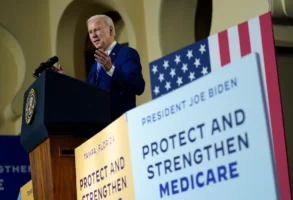Published December 1, 2014
In the 2014 midterm elections, opposition to the Affordable Care Act — i.e., Obamacare — was a clear political winner. That’s obvious from the election results themselves but also from polling that consistently finds that far more of the electorate disapproves of the law than approves of it.
It is therefore to be expected that the incoming Congress, fully under the control of the GOP, will vote on a straight repeal bill, probably very early in next session. In the House, such a bill will pass easily. But in the Senate, Democrats will control at least 46 seats in the new Congress, giving them plenty of votes to filibuster most legislation they oppose. Consequently, the most likely scenario is that the repeal legislation will die in the Senate and therefore never get sent to the president for a certain veto.
Perhaps that’s just as well, because repeal without a replacement plan is not the best long-term position for ACA opponents anyway. The ultimate goal should be enactment of a plan that is far better than the ACA, with broader and deeper public support.
The electorate is deeply uneasy about the ACA’s approach to reform, for good reasons. It cedes massive new authority over the health system to the federal government. That will lead, inevitably, to more regulation and a lowering of the quality of American health care. The law is also terribly expensive and a wet blanket on the American economy at a time when middle-class incomes are stagnant.
But that doesn’t mean the public is eager to go back to the pre-ACA status quo, which is what is implied with a bill that repeals the ACA but does not replace it. President Obama got one thing right about American health care in 2009: It needed to be reformed – just not in the way he advocated. The pre-ACA health system left too many Americans with inadequate and insecure insurance, treated individuals unfairly who bought insurance on their own, allowed too many people with preexisting conditions to fall through regulatory cracks, and inflated costs with open-ended federal entitlement programs and tax subsidies.
The ACA’s answer to these problems was to consolidate power over the entire system within the federal government. But that’s exactly why the public is so uneasy about what passed in 2010 (in addition to being unhappy with the process that was used to enact it). The door is open for ACA opponents to present an alternative vision for reform that addresses the real problems in American health care without the big-government baggage of the ACA.
The task for ACA opponents has been made more complicated (in a good way) by the Supreme Court’s recent decision to take up the King v. Burwell case. Previously, the assumption was that while Congress might be able to make some incremental progress toward repealing and replacing the ACA in 2015, the real action would not take place until 2017, and real progress would happen then only if a Republican succeeded President Obama in the White House. Based on that assumption, the thinking up to now has been that Republicans would need to slowly coalesce around a consensus replacement plan over the next year or so, as numerous ideas were considered and debated both in Congress and among the competing presidential candidates. That consensus plan could then be an important plank in the GOP nominee’s platform going into the 2016 campaign.
The King case upends this timing. If the Supreme Court sides with the plaintiff and disallows the payment of premium credits in the federally built exchanges, the GOP will have been handed a not-to-be-missed opportunity to begin replacing the ACA with something far better. Republicans in Congress must have a plan ready well in advance of the Supreme Court’s decision (probably next June) to take full advantage of this potential opportunity.
So what should the plan be? Here it is best to think first about what a full replacement plan should look like — the kind that might be fully enacted with a Republican president in 2017 — and then to consider what might be done if the Supreme Court stops the payment of premium credits in federal exchanges in mid-2015.
The starting point for a full replacement plan should be a rational synthesis of the two best reform plans now on the table: one developed by the 2017 Project (a group dedicated to developing a conservative reform agenda for the next administration) and the other by Republican Senators Richard Burr, Tom Coburn, and Orrin Hatch. The two plans share much in common. They are practical, market-based solutions. They both retain the employer-based health-insurance system for the vast majority of Americans, even as they would encourage more cost discipline in the most expensive job-based plans with a limitation on the federal tax break for employer-paid premiums. To broaden insurance enrollment and to correct an inequity in current law, they also would provide a new federal tax credit to households without access to employer coverage. The credit would be adjusted by age (and, in the case of Burr-Coburn-Hatch, by income) and could be used to purchase any state-approved health-insurance product. Finally, the plans would create a new “continuous-coverage protection” construct: People who stay continuously enrolled in health insurance would be protected from premium hikes based on their health status and from exclusions from coverage based on a preexisting condition.
These reforms would give all Americans access to secure, affordable health insurance without the mandates, regulations, and massive expense of the ACA.
If the Supreme Court disallows premium credits in the federal exchanges, the president and his supporters will demand immediate action by Congress to restore the credits to prevent anyone from losing their health insurance. This will be a potent political argument. The GOP must therefore be ready with an alternative that uses the much more flexible tax credits envisioned in the 2017 Project and Burr-Coburn-Hatch plans. These credits could be used for insurance plans not offered on the exchanges and with coverage that differs from the ACA’s mandates.
The GOP alternative could also provide the states with the authority to reform Medicaid into a premium-support model without the need of a waiver from the Department of Health and Human Services. Medicaid could then work seamlessly with the federal tax credits to provide low-income Americans with better private-insurance options.
All will not be lost if the Supreme Court sides with the administration in the Kingcase. Republicans could still advance their replace ideas — along with the many good ideas for repealing the worst features of the ACA — through the budget process. And it is possible, though not likely, that some aspects of repeal and replace would actually make it into law because President Obama was forced to accept them as part of a larger compromise package.
But little progress will be made if ACA opponents remain deeply divided over what should be the replacement approach.
The hard work of developing a credible alternative plan has already been mostly completed. What is needed now is a spirit of practical compromise among key Republican policymakers. It will not be possible to beat an incumbent program — the ACA — with abstractions, good intentions, and idealistic concepts. What’s needed is a workable, politically viable plan, one that voters can see for themselves would work better than the ACA. Now is the time to embrace that kind of plan and begin preparing the way for its full or partial enactment at the first opportunity.
— James C. Capretta is a senior fellow at the Ethics and Public Policy Center and a visiting fellow at the American Enterprise Institute.







